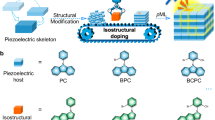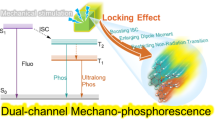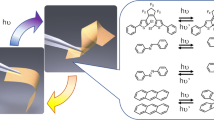Abstract
Altering the shape and properties of a material through external factors such as heat, light, pressure, pH, electric or magnetic fields, or the introduction of a guest molecule, is an attractive prospect. In this Perspective, piezochromic luminescent materials — which change the colour of their luminescence in response to mechanical stimuli — are described. Such piezochromism has been observed for a few molecular materials that contain luminescent cores in liquid-crystalline and crystalline solid states, as well as for polymeric materials doped with dyes. These changes in photoluminescent colour can be activated by various types of mechanical pressure such as shearing, grinding or elongation, which can trigger different mechanisms of producing the colour. Such stimuli-responsive materials have potential for various applications, including sensors, memory and displays.
This is a preview of subscription content, access via your institution
Access options
Subscribe to this journal
Receive 12 print issues and online access
$259.00 per year
only $21.58 per issue
Buy this article
- Purchase on Springer Link
- Instant access to full article PDF
Prices may be subject to local taxes which are calculated during checkout






Similar content being viewed by others
References
Lehn, J-M. Toward self-organization and complex matter. Science 295, 2400–2403 (2002).
Whitesides, G. M. & Grzybowski, B. Self-assembly at all scales. Science 295, 2418–2421 (2002).
Reinhoudt, D. N. & Crego-Calama, M. Synthesis beyond the molecule. Science 295, 2403–2407 (2002).
Kato, T. Self-assembly of phase-segregated liquid crystal structures. Science 295, 2414–2418 (2002).
Kato, T., Mizoshita, N. & Kishimoto, K. Functional liquid-crystalline assemblies: Self-organized soft materials. Angew. Chem. Int. Ed. 45, 38–68 (2005).
Ciferri, A. (ed.) Supramolecular Polymers 2nd edn (Taylor & Francis, 2005).
Demus, D., Goodby, J. W., Gray, G. W., Spiess, H-W. & Vill, V. (eds) Handbook of Liquid Crystals (Wiley-VCH, 1998).
Ikeda, T., Mamiya, J-I. & Yu, Y. Photomechanics of liquid-crystalline elastomers and other polymers. Angew. Chem. Int. Ed. 46, 506–528 (2007).
Schneider, H-J., Tianjun, L. & Lomadze, N. Molecular recognition in a supramolecular polymer system translated into mechanical motion. Angew. Chem. Int. Ed. 42, 3544–3546 (2003).
Harun-Ur-Rashid, M., Seki, T. & Takeoka, Y. Structural colored gels for tunable soft photonic crystals. Chem. Rec. 9, 87–105 (2009).
Yerushalmi, R., Scherz, A., van der Boom, M. E. & Kraatz, H-B. Stimuli responsive materials: new avenues toward smart organic devices. J. Mater. Chem. 15, 4480–4487 (2005).
Turro, N. J. Modern Molecular Photochemistry (University Science Books, 1978).
Valeur, B. Molecular Fluorescence: Principles and Applications (Wiley-VCH, 2002).
Mutai, T., Satou, H. & Araki, K. Reproducible on–off switching of solid-state luminescence by controlling molecular packing through heat-mode interconversion. Nature Mater. 4, 685–687 (2005).
Sagara, Y., Mutai, T., Yoshikawa, I. & Araki, K. Material design for piezochromic luminescence: hydrogen-bond-directed assemblies of a pyrene derivative. J. Am. Chem. Soc. 129, 1520–1521 (2007).
Balch, A. L. Dynamic crystals: visually detected mechanochemical changes in the luminescence of gold and other transition-metal complexes. Angew. Chem. Int. Ed. 48, 2641–2644 (2009).
Sagara, Y. & Kato, T. Stimuli-responsive luminescent liquid crystals: change of photoluminescent colors triggered by a shear-induced phase transition. Angew. Chem. Int. Ed. 47, 5175–5178 (2008).
Sagara, Y., Yamane, S., Mutai, T., Araki, K. & Kato, T. A stimuli-responsive, photoluminescent, anthracene-based liquid crystal: emission color determined by thermal and mechanical processes. Adv. Funct. Mater. 19, 1869–1875 (2009).
Kozhevnikov, V. N., Donnio, B. & Bruce, D. W. Phosphorescent, terdentate, liquid-crystalline complexes of platinum(II): stimulus-dependent emission. Angew. Chem. Int. Ed. 47, 6286–6289 (2008).
Kunzelman, J., Kinami, M., Crenshaw, B. R., Protasiewicz, J. D. & Weder, C. Oligo(p-phenylene vinylene)s as a 'new' class of piezochromic fluorophores. Adv. Mater. 20, 119–122 (2008).
Mizukami, S. et al. Fluorescence color modulation by intramolecular and intermolecular π–π interactions in a helical zinc(II) complex. Chem. Mater. 17, 50–56 (2005).
Ito, H. et al. Reversible mechanochromic luminescence of [(C6F5Au)2(μ-1,4-diisocyanobenzene)]. J. Am. Chem. Soc. 130, 10044–10045 (2008).
Lee, Y-A. & Eisenberg, R. Luminescence tribochromism and bright emission in gold(I) thiouracilate complexes. J. Am. Chem. Soc. 125, 7778–7779 (2003).
Abe, T., Itakura, T., Ikeda, N. & Shinozaki, K. Luminescence color change of a platinum(II) complex solid upon mechanical griding. Dalton Trans. 711–715 (2009).
Löwe, C. & Weder, C. Oligo(p-phenylene vinylene) excimers as molecular probes: Deformation-induced color changes in photoluminescent polymer blends. Adv. Mater. 14, 1625–1629 (2002).
Crenshaw, B. R. & Weder, C. Deformation-induced color changes in melt-processed photoluminescent polymer blends. Chem. Mater. 15, 4717–4724 (2003).
Kinami, M., Crenshaw, B. R. & Weder, C. Polyesters with built-in threshold temperature and deformation sensors. Chem. Mater. 18, 946–955 (2006).
Pucci, A., Di Cuia, F., Signori, F. & Ruggeri, G. Bis(benzoxazolyl)stilbene excimers as temperature and deformation sensors for biodegradable poly(1,4-butylene succinate) films. J. Mater. Chem. 17, 783–790 (2007).
Laschat, S. et al. Discotic liquid crystals: From tailor-made synthesis to plastic electronics. Angew. Chem. Int. Ed. 46, 4832–4887 (2007).
O'Neill, M. & Kelly, S. M. Liquid crystals for charge transport, luminescence, and photonics. Adv. Mater. 15, 1135–1146 (2003).
Wooley, K. L., Hawker, C. J. & Fréchet, J. M. J. Unsymmetrical three-dimensional macromolecules: Preparation and characterization of strongly dipolar dendritic macromolecules. J. Am. Chem. Soc. 115, 11496–11505 (1993).
Tomalia, D. A. & Fréchet, J. M. J. Discovery of dendrimers and dendritic polymers: A brief historical perspective. J. Polym. Sci. A 40, 2719–2728 (2002).
Percec, V., Cho, W-D., Ungar, G. & Yeardley, D. J. P. Synthesis and structural analysis of two constitutional isomeric libraries of AB2-based monodendrons and supramolecular dendrimers. J. Am. Chem. Soc. 123, 1302–1315 (2001).
Percec, V. et al. Synthesis and retrostructural analysis of libraries of AB3 and constitutional isomeric AB2 phenylpropyl ether-based supramolecular dendrimers. J. Am. Chem. Soc. 128, 3324–3334 (2006).
Saez, I. M. & Goodby, J. W. Supermolecular liquid crystals. Struct. Bond. 128, 1–62 (2008).
Deschenaux, R., Donnio, B. & Guillon, D. Liquid-crystalline fullerodendrimers. New J. Chem. 31, 1064–1073 (2007).
Kato, T. Hydrogen-bonded liquid crystals: Molecular self-assembly for dynamically functional materials. Struct. Bond. 96, 95–146 (2000).
Kobayashi, Y. & Matsunaga, Y. New discogenic compounds: N,N'-Dialkanoyl-2,3,5,6-tetrakis(alkanoyloxy)-1,4-benzenediamines. Bull. Chem. Soc. Jpn 60, 3515–3518 (1987).
Birks, J. B. Excimers. Rep. Prog. Phys. 38, 903–974 (1975).
Winnik, F. M. Photophysics of preassociated pyrenes in aqueous polymer solutions and in other organized media. Chem. Rev. 93, 587–614 (1993).
Tsujii, Y. et al. Multilayer films of chromophoric cellulose octadecanoates studied by fluorescence spectroscopy. Langmuir 8, 936–941 (1992).
Chen, Z. et al. Photoluminescence and conductivity of self-assembled π–π stacks of perylene bisimide dyes. Chem. Eur. J. 13, 436–449 (2007).
Pujolle-Robic, C. & Noirez, L. Observation of shear-induced nematic–isotropic transition in side-chain liquid crystal polymers. Nature 409, 167–171 (2001).
Yamamoto, J. & Tanaka, H. Shear-induced sponge-to-lamellar transition in a hyperswollen lyotropic system. Phys. Rev. Lett. 77, 4390–4393 (1996).
Davis, D. A. et al. Force-induced activation of covalent bonds in mechanoresposive polymeric materials. Nature 459, 68–72 (2009).
Weder, C. Mechanochemistry: Polymers react to stress. Nature 459, 45–46 (2009).
Yamamoto, T. et al. Preparation of new main-chain type polyanthraquinones. Chemical reactivity, packing structure, piezochromism, conductivity, and liquid crystalline and photonic properties of the polymers. Chem. Mater. 15, 4384–4393 (2003).
Yoshio, M., Mukai, T., Ohno, H. & Kato, T. One-dimensional ion transport in self-organized columnar ionic liquids. J. Am. Chem. Soc. 126, 994–995 (2004).
Author information
Authors and Affiliations
Corresponding author
Rights and permissions
About this article
Cite this article
Sagara, Y., Kato, T. Mechanically induced luminescence changes in molecular assemblies. Nature Chem 1, 605–610 (2009). https://doi.org/10.1038/nchem.411
Published:
Issue Date:
DOI: https://doi.org/10.1038/nchem.411
This article is cited by
-
Preparation of photonic molecular trains via soft-crystal polymerization of lanthanide complexes
Nature Communications (2022)
-
ESIPT-regulated Mechanoresponsive Luminescence Process by Introducing Intramolecular Hydrogen Bond in Naphthalimide Derivatives
Chemical Research in Chinese Universities (2022)
-
Pressure-induced photoluminescence enhancement and ambient retention in confined carbon dots
Nano Research (2022)
-
Versatile non-luminescent color palette based on guest exchange dynamics in paramagnetic cavitands
Nature Communications (2021)
-
Dynamic multimodal holograms of conjugated organogels via dithering mask lithography
Nature Materials (2021)



